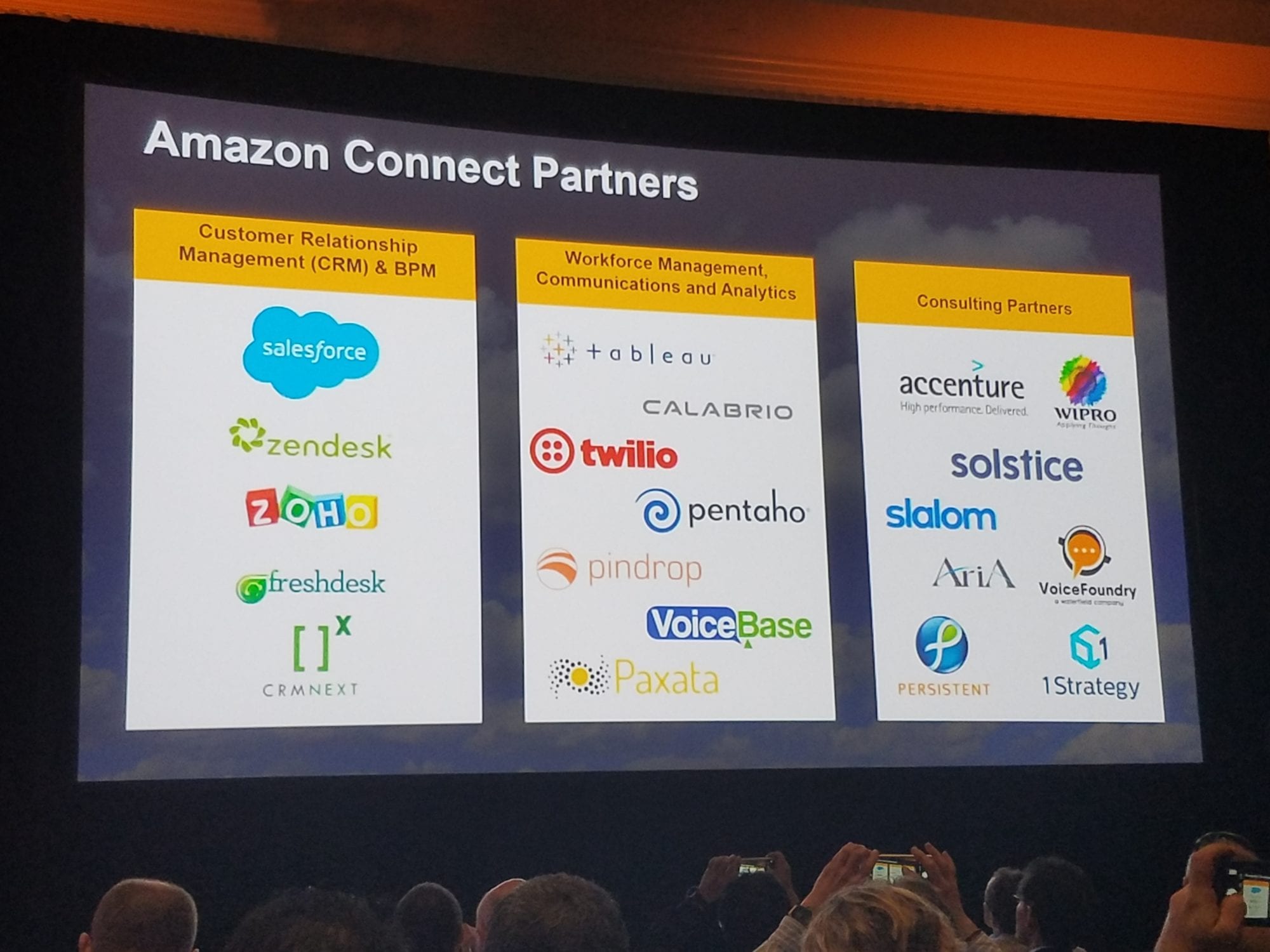
“Enterprise Connect 2017 was one of the better shows I’ve been to in years…” This was a sentiment we heard over and over, among attendees, exhibitors and analysts at the show this year.
This year’s Enterprise Connect conference was a show in transition, it was palpable and it was exciting. The floor plan had traded Avaya for Amazon Web Services, (who kept their booth covered on Day 1 until their announcement was made live) and the show messaging turned from legacy telecom to open and flexible APIs. This was most noticeable in Jeff Lawson’s keynote where he touted “people want businesses to treat them like humans again,” they are looking for solutions that are “customizable, fast, low risk and resilient,” and to hammer his point home he pronounced “Nike now deploys more software engineers than they do shoe designers.” His point being, developers are everywhere, even in enterprises, and they are looking for solutions that don’t just fit their needs today, but also far into the foreseeable future. This is where the value of APIs come into play.
As a leading cloud-based speech analytics provider, VoiceBase was thrilled to see the themes of this year’s conference have so much alignment with our own messaging. Our biggest product demonstration that garnered the most attention was VoiceBase Real Real-time transcription, which included real-time speech analytics and sentiment analysis. With a close second being our announcement in joining Amazon’s Partner Network in support of Amazon Connect.
All in all, it was a great show, below are the announcements that went live last week:
- AWS Announces Amazon Connect
- VoiceBase to Extend its Cloud Contact Center Reach Through Support of Amazon Connect
- VoiceBase EU Set to Launch in April Ensuring the Protection of European Customers’ Data
ENTERPRISE CONNECT 2017 TRENDS
Developers are everywhere, and telecom companies are finally taking notice and following in the footsteps of Twilio to create API offerings that have the quick, simple, and accessible tools developers need. On the show floor we saw other companies, including ShoreTel, Mitel, Vidyo, Vonage, and Voxbone, demonstrate their emerging API offerings for everything from real-time voice enabled bots to embedded video conferencing and video streaming. If after that show you are still concerned about switching from on-premise solutions to cloud-based ones, for scalability or security reasons, you are behind the times my friend.
2. Team collaboration is taking over
With the increase in the last few years of companies hiring virtual, cross-functional teams, the need for better team collaboration tools has increased in tandem. It seemed as though every large telco showed up with a cloud strategy and a team collaboration strategy; Cisco & Spark, BroadSoft & Team-One, RingCentral, Mitel & MiTeam, Microsoft & Teams, 8×8 & SameRoom, etc etc. Clearly there is a pattern here.
3. Amazon Connect
Amazon Web Services took over the show and the buzz when they announced Tuesday morning the emergence of Amazon Connect. Amazon Connect is a self-service, cloud-based contact center service that makes it easy for any business to deliver better customer service at lower cost. Gene Farrell and Tom Weiland from AWS explained that Connect was originally built as a solution to their own problem – “traditional contact center solutions were unable to meet our demanding requirements.” The available solutions were complex, with multiple components from multiple vendors. The tools were cumbersome, requiring niche expertise, and they were in proprietary environments requiring “esoteric” skills. Along with other drawbacks, existing solutions were described as having complex pricing requiring long-term commitments.

Amazon Connect is based on the same contact center technology used by Amazon customer service associates around the world to power millions of customer conversations. The self-service graphical interface in Amazon Connect makes it easy for non-technical users to design contact flows, manage agents, and track performance metrics – no specialized skills required. There are no up-front payments or long-term commitments and no infrastructure to manage with Amazon Connect; customers pay by the minute for Amazon Connect usage plus any associated telephony services.
4. Experience is Crucial
The term omnichannel has been around for awhile, but it seems like it might be closer to actually becoming a reality after this conference. The customer experience will always be a huge focus and ever-changing element of enterprises; it is simply too important to ever take your eye off of it. And now with machine learning and AI making its way into the hearts of telecom execs and decision makers, real improvements are now able to be envisioned. For example, imagine that a customer service agent can see real-time sentiment analysis of their call. If their customer’s sentiment drops below an acceptable rate, a bot can then automatically dial in a supervisor to turn that call around. Another example is a sales agent who can now close a larger sale than before by getting real-time insights on which of the 3 products their customer is most likely to be successfully up-sold on based on previous call patterns. These types of scenarios are only the beginning.
5. Analytics are the ‘Good Stuff’
Reliable connectivity is just table-stakes at Enterprise Connect. The ‘good stuff’ out of every call, conference, webinar, or video is what’s said, and the more data that a service provider can deliver to their customers from this juicy source will be the differentiator in the future. The goal of data and analytics are to help businesses make better decisions, which is the underlying element of so many of these other themes/trends from the show. I expect this to be a growing element and to see much more on company’s strategies to deliver the best analytics in 2018.
Below we discuss the 5 most exciting trends from the conference for VoiceBase and the Unified Communications industry:
1. APIs > Everything
Developers are everywhere, and telecom companies are finally taking notice and following in the footsteps of Twilio to create API offerings that have the quick, simple, and accessible tools developers need. On the show floor we saw other companies, including ShoreTel, Mitel, Vidyo, Vonage, and Voxbone, demonstrate their emerging API offerings for everything from real-time voice enabled bots to embedded video conferencing and video streaming. If after that show you are still concerned about switching from on-premise solutions to cloud-based ones, for scalability or security reasons, you are behind the times my friend.
2. Team collaboration is taking over
With the increase in the last few years of companies hiring virtual, cross-functional teams, the need for better team collaboration tools has increased in tandem. It seemed as though every large telco showed up with a cloud strategy and a team collaboration strategy; Cisco & Spark, BroadSoft & Team-One, RingCentral, Mitel & MiTeam, Microsoft & Teams, 8×8 & SameRoom, etc etc. Clearly there is a pattern here.
3. Amazon Connect
Amazon Web Services took over the show and the buzz when they announced Tuesday morning the emergence of Amazon Connect. Amazon Connect is a self-service, cloud-based contact center service that makes it easy for any business to deliver better customer service at lower cost. Gene Farrell and Tom Weiland from AWS explained that Connect was originally built as a solution to their own problem – “traditional contact center solutions were unable to meet our demanding requirements.” The available solutions were complex, with multiple components from multiple vendors. The tools were cumbersome, requiring niche expertise, and they were in proprietary environments requiring “esoteric” skills. Along with other drawbacks, existing solutions were described as having complex pricing requiring long-term commitments.

Amazon Connect is based on the same contact center technology used by Amazon customer service associates around the world to power millions of customer conversations. The self-service graphical interface in Amazon Connect makes it easy for non-technical users to design contact flows, manage agents, and track performance metrics – no specialized skills required. There are no up-front payments or long-term commitments and no infrastructure to manage with Amazon Connect; customers pay by the minute for Amazon Connect usage plus any associated telephony services.
4. Experience is Crucial
The term omnichannel has been around for awhile, but it seems like it might be closer to actually becoming a reality after this conference. The customer experience will always be a huge focus and ever-changing element of enterprises; it is simply too important to ever take your eye off of it. And now with machine learning and AI making its way into the hearts of telecom execs and decision makers, real improvements are now able to be envisioned. For example, imagine that a customer service agent can see real-time sentiment analysis of their call. If their customer’s sentiment drops below an acceptable rate, a bot can then automatically dial in a supervisor to turn that call around. Another example is a sales agent who can now close a larger sale than before by getting real-time insights on which of the 3 products their customer is most likely to be successfully up-sold on based on previous call patterns. These types of scenarios are only the beginning.
5. Analytics are the ‘Good Stuff’
Reliable connectivity is just table-stakes at Enterprise Connect. The ‘good stuff’ out of every call, conference, webinar, or video is what’s said, and the more data that a service provider can deliver to their customers from this juicy source will be the differentiator in the future. The goal of data and analytics are to help businesses make better decisions, which is the underlying element of so many of these other themes/trends from the show. I expect this to be a growing element and to see much more on company’s strategies to deliver the best analytics in 2018.
[/et_pb_text][/et_pb_column][/et_pb_row][/et_pb_section]Although Amazon Connect took over most of the excitement and buzz at this year’s show, there were some other themes that still shone through, from the interest and questions in our booth as well as in the keynote and panel topics. VoiceBase CRO & Co-founder Jay Blazensky was on two panels during the conference; Voice as the User Interface: Is It Ready for Prime Time? as well as The Role of CPaaS in Mobilizing Enterprises. Both panels had common themes being; how new technology, such as CPaaS and speech analytics are being used in the enterprise, and what value are enterprises seeing here? Per usual, Jay’s comments garnered some tweets quoting his responses and views on the industry and how things are changing:
Below we discuss the 5 most exciting trends from the conference for VoiceBase and the Unified Communications industry:
1. APIs > Everything
Developers are everywhere, and telecom companies are finally taking notice and following in the footsteps of Twilio to create API offerings that have the quick, simple, and accessible tools developers need. On the show floor we saw other companies, including ShoreTel, Mitel, Vidyo, Vonage, and Voxbone, demonstrate their emerging API offerings for everything from real-time voice enabled bots to embedded video conferencing and video streaming. If after that show you are still concerned about switching from on-premise solutions to cloud-based ones, for scalability or security reasons, you are behind the times my friend.
2. Team collaboration is taking over
With the increase in the last few years of companies hiring virtual, cross-functional teams, the need for better team collaboration tools has increased in tandem. It seemed as though every large telco showed up with a cloud strategy and a team collaboration strategy; Cisco & Spark, BroadSoft & Team-One, RingCentral, Mitel & MiTeam, Microsoft & Teams, 8×8 & SameRoom, etc etc. Clearly there is a pattern here.
3. Amazon Connect
Amazon Web Services took over the show and the buzz when they announced Tuesday morning the emergence of Amazon Connect. Amazon Connect is a self-service, cloud-based contact center service that makes it easy for any business to deliver better customer service at lower cost. Gene Farrell and Tom Weiland from AWS explained that Connect was originally built as a solution to their own problem – “traditional contact center solutions were unable to meet our demanding requirements.” The available solutions were complex, with multiple components from multiple vendors. The tools were cumbersome, requiring niche expertise, and they were in proprietary environments requiring “esoteric” skills. Along with other drawbacks, existing solutions were described as having complex pricing requiring long-term commitments.

Amazon Connect is based on the same contact center technology used by Amazon customer service associates around the world to power millions of customer conversations. The self-service graphical interface in Amazon Connect makes it easy for non-technical users to design contact flows, manage agents, and track performance metrics – no specialized skills required. There are no up-front payments or long-term commitments and no infrastructure to manage with Amazon Connect; customers pay by the minute for Amazon Connect usage plus any associated telephony services.
4. Experience is Crucial
The term omnichannel has been around for awhile, but it seems like it might be closer to actually becoming a reality after this conference. The customer experience will always be a huge focus and ever-changing element of enterprises; it is simply too important to ever take your eye off of it. And now with machine learning and AI making its way into the hearts of telecom execs and decision makers, real improvements are now able to be envisioned. For example, imagine that a customer service agent can see real-time sentiment analysis of their call. If their customer’s sentiment drops below an acceptable rate, a bot can then automatically dial in a supervisor to turn that call around. Another example is a sales agent who can now close a larger sale than before by getting real-time insights on which of the 3 products their customer is most likely to be successfully up-sold on based on previous call patterns. These types of scenarios are only the beginning.
5. Analytics are the ‘Good Stuff’
Reliable connectivity is just table-stakes at Enterprise Connect. The ‘good stuff’ out of every call, conference, webinar, or video is what’s said, and the more data that a service provider can deliver to their customers from this juicy source will be the differentiator in the future. The goal of data and analytics are to help businesses make better decisions, which is the underlying element of so many of these other themes/trends from the show. I expect this to be a growing element and to see much more on company’s strategies to deliver the best analytics in 2018.
[/et_pb_text][/et_pb_column][/et_pb_row][/et_pb_section]

